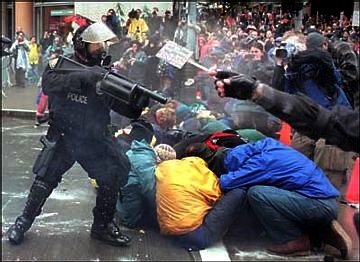By Prof. James F. Tracy Global Research, December 10, 2014
Close to three weeks have passed since the mass shooting incident at Florida State University where three individuals were injured and Attorney Myron May perished in a hail of police gunfire.
Major news media consider the FSU shooting more or less a closed case. After all, journalists appear to have been spoon-fed a story that includes its own sort of “The End” moment. A madman with a gun showed up in a public place. Terrified witnesses were interviewed and their fearful testimony publicized. The shooter’s bizarre online statements were duly noted. Then, official pleas for “unity,” “strength,” and “healing” were unquestioningly parroted, and less than two days later the entire affair was capped off with a photo op candlelight vigil.

With the notion of a full scale, coordinated media production in mind, it should be unsurprising that law enforcement and news media now consider themselves to be “partners” in such a tragedy’s public presentation. A November 21 press statement from Tallahassee Police Public Affairs Officer David Northway to select news media reads:
As the investigation into the tragedy at FSU continues, the Tallahassee Police Department is releasing the original report written on the night of the event. This report is short in nature as it was written to be a “starting point” as the crime scene was very large and the multiple officers on scene that evening had many duties, including identifying victims, evacuating the students and maintaining scene security …
TPD would like to thank our media partners for their patience with the incident, in particular releasing the identity of the victims. This has allowed TPD to conduct interviews with some of them and begin to piece the facts of the case together.
Why would police refer to journalists as “media partners” in the affair? One of the first things a fledgling journalist learns in J-school is to take a skeptical and discerning stance in her/his reportage on public affairs and personages. Here Tallahassee police go so far as to suggest that the very publicity generated around the victims facilitated their interrogation.
The “media partners” remark is emblematic of the now common amalgamation of reporter and publicity hack. In the context of the similarly routine “active shooter” exercises committed in the presence of unwitting bystanders, it curiously echoes a 2008 plan for carrying out a Boston Marathon-related mass casualty drill, where officials emphasized “[w]orking with the media … Building a longstanding relationship with journalists and reporters,” the blueprint reads, “ensures that they get the right story and that they serve as a resource when needed.”[1]
Police Records Remain Withheld
Citing an “ongoing investigation” (Section 119.071(2)(c), Florida Statute) FSU and Tallahassee police departments immediately involved in the incident have yet to release any substantive documentation addressing what actually took place in the early morning hours of November 21, 2014 in front of FSU’s campus library.
Excepting press conferences and severely redacted police reports (here and here) virtually no forensic information has been made available to news media and the broader public on the incident. Such records would include closed-circuit video footage of the incident, photographs of evidence and crime scene, detailed officer and eyewitness accounts, and forensic details of May’s fatal injuries.
In a pro forma maneuver, the “active criminal investigative and intelligence exemption” of Florida’s public records law is being invoked by Tallahassee and FSU police as an inquiry by Leon County’s Attorney ensues over whether Tallahassee and FSU officers used inordinate force against May in responding to the incident.

“Traditionally, the State Attorney in this circuit has taken all officer-involved shootings to the Grand Jury,” Tallahassee Assistant City Attorney Richard Courtemanche remarked in response to a public records request, concluding that the Grand Jury will likely hear the case by December 17, at which time the records will be made public.
Although FSU police comprised the overall majority of officers responding to the event and present when May was fatally shot, the university was ambiguous concerning whether such records would be forthcoming. On December 8 FSU counsel recommended that MHB’s public records request be refiled “at a later date, at which time records may be available.”
Public Titillated, Ill-Informed
Law enforcement’s “media partners” exhibited a feeding frenzy in the hours and days following the FSU shooting, taking advantage of most every reportorial technique to sensationalize the tragedy. In keeping with the “mentally ill gunman” news frame, they have failed to seriously ponder whether inordinate force was deployed in dealing with a clearly distressed figure, not to mention the party’s repeated claims to be a target of electronic surveillance and harassment–well documented technologies and methods for compromising individuals.
In the unusual rash of mass shooting incidents over the past few years, the most prominent occurring in Tucson, Aurora, and Newtown, official investigations have been glaringly slipshod and opaque, leaving an array of unanswered questions and missing information.

In the Isla Vista and Las Vegas shootings in early 2014, for example, dubious crime scene investigations were conducted while police reports and related documentation still remains under wraps. As one mass shooting follows on the heels of another, the public is poorly served by a news media far more concerned with fleeting titillation than genuinely delving into what really happened in each instance.
Note
[1] James F. Tracy, “Obama’s FEMA Director Planned Boston Mass Casualty Event in 2008,” MemoryHoleBlog.com, May 21, 2013. Since the mid-2000s FEMA’s Integrated Public Alert and Warning System and Digital Emergency Alert System, working in coordination with broadcast and social media, constitute an apparatus that can effectively control important elements of the broader public’s perceptions and sentiment. FEMA’s Integrated Capstone Event (ICE) is a comprehensive exercise involving a “multi-disciplined response” of federal, state, and local emergency responders reacting in unison to a common mass casualty event. According to FEMA, “Each scenario focuses on the foundations of CDP training—incident management, mass casualty response, and emergency response to a catastrophic natural disaster or terrorist act.” Shannon Arledge, “Integrated Capstone Event Merges Four Mass Casualty Response Courses,” FEMA.gov, last updated May 28, 2013. See also Tracy, “Mass Traumatization and the Body Politic,” MemoryHoleBlog.com, July 2, 2013.
